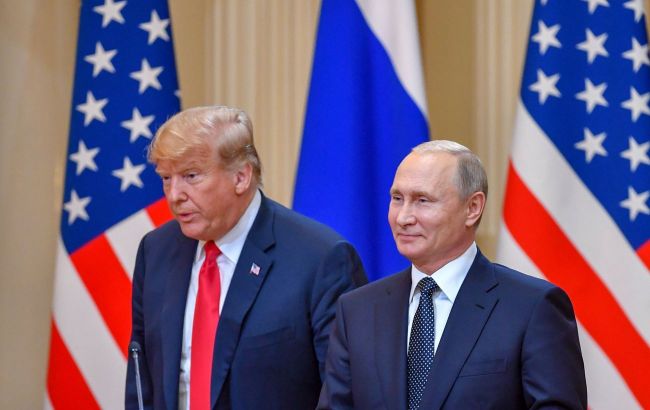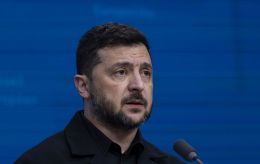Putin's energy strike pause: Who gains more – Russia or Ukraine
 US and Russian Presidents Donald Trump and Vladimir Putin (photo: Getty images)
US and Russian Presidents Donald Trump and Vladimir Putin (photo: Getty images)
Ukraine and Russia, with the mediation of the United States, are negotiating a moratorium on attacks against energy infrastructure. So far, this has not been formalized in any document, but the intensity of attacks on energy facilities is currently somewhat lower than in recent months—more details on who benefits most from this ceasefire – in the RBC-Ukraine's article.
Contents
Ukraine confirms readiness to refrain from attacking Russian energy infrastructure.
This was one of the results of technical consultations between representatives of Ukraine and the US on March 25 in Riyadh.
"All (Ukraine and the US – ed.) parties agreed to implement the agreements between the presidents on a complete ban on strikes against the energy infrastructure of Ukraine and Russia," Ukrainian Defense Minister Rustem Umerov said following the consultations.
Additional consultations will take place in the near future to agree on details, monitoring mechanisms, and compliance control. Third-party countries may be involved in this process.
At the political level, the cessation of mutual strikes on Ukraine and Russia's energy infrastructure was agreed upon by the presidents of the US and Russia on March 18.
Although Ukraine had previously supported Washington's proposal for a 30-day comprehensive ceasefire, Kyiv did not reject the partial moratorium on energy strikes either. Ukraine backed the idea but noted that the specific implementation details remained unclear.
"After we receive details from the American president, from the American side, we will prepare our response, and the team will be ready for a technical discussion," Ukrainian President Volodymyr Zelenskyy said.
According to an informed source in the energy sector interviewed by RBC-Ukraine, neither Ukraine nor Russia has conducted large-scale strikes on energy facilities for several days.
However, Presidential Advisor Dmytro Lytvyn reported that since March 18, at least 8 confirmed Russian attacks on Ukrainian energy facilities had been recorded. He noted that these attacks were carried out using strike drones and FPV drones.
Given this, relying on Russia's commitment to any agreements would be reckless.
Following the Riyadh consultations, President Zelenskyy announced that Ukraine had submitted to the US a list of energy infrastructure sites that should not be targeted. Sources from RBC-Ukraine clarified that this list does not specify individual facilities but rather categories, such as: energy resource extraction facilities, electricity generation infrastructure, and energy transportation facilities.
Russia also submitted a list similar to the US's, which was agreed upon during consultations. The list includes oil refineries; oil and gas pipelines, storage facilities, pumping stations; infrastructure that produces and transmits electricity, including power plants, substations, transformers, and distribution centers; Nuclear power plants; Hydroelectric dam facilities.
Russia started lying on the first day of the agreement
The temporary 30-day moratorium on energy infrastructure strikes, according to the Kremlin’s statement, has been in effect since March 18 and may be extended. However, if the moratorium is violated, either side may withdraw from the agreement.
Nevertheless, as mentioned earlier, this "ceasefire" has not been formalized in any document so far.
President Volodymyr Zelenskyy has already called Russia’s statements lies.
"And there is something else the Kremlin is lying about again: that the silence in the Black Sea allegedly depends on sanctions and that the supposed start date of the energy ceasefire is March 18. Moscow always lies. And it depends on the world – on everyone who truly wants peace – whether they will once again allow Moscow to lie," Zelenskyy said.
Commenting on the outcome of the US consultations, Zelenskyy emphasized that all agreements reached on March 24 take effect specifically from March 24, including the ceasefire on energy facilities.
Thus, the moratorium does not end on April 18, but on April 24.
Regardless, there are still at least three weeks ahead during which Ukraine and Russia have committed to refraining from energy strikes.
If someone violates the agreement, the US will act as the arbitrator – at least, this is Ukraine’s stance.
"As of today, we have such an agreement that if we see that someone violates it, as we believe, we will appeal through all our channels to the American side with the evidence that the Russian side has violated the (ceasefire – ed..)," Zelenskyy stated.
The likelihood that Russia will violate the agreement and abandon the moratorium remains high.
On the very day of the negotiations, the Russian Ministry of Defense accused Ukraine of attacks on energy infrastructure in the Krasnodar region and some occupied territories, as usual, without providing any evidence.
What Russia and Ukraine have been targeting
Drones began systematically attacking Russia’s energy facilities from the fall of 2023. The main targets were oil refineries and oil depots. By the end of 2024, there had been around a hundred attacks, including in Krasnodar Krai, Belgorod, Smolensk, Nizhny Novgorod, Tula, and Leningrad regions. In 2024, gasoline production in Russia decreased by 6.4%, to 41.1 million tons, and diesel production by 7.4%, to 81.6 million tons.

Fire at an energy facility after Ukrainian attacks (photo: Getty Images)
Since the beginning of 2025, oil facilities in ten regions of the aggressor country have been targeted. According to Ukrainian intelligence, around a third of Russia’s oil facilities, used for military purposes, have been damaged. The result is that the price of oil products in Russia has risen and continues to increase. Currently, the average price of gasoline is already $0.71 per liter (in December it was $0.60), and diesel fuel is $0.85 (in December it was $0.75). Gasoline exports are limited until the end of 2025. As a result of attacks in 2025, losses at the Volgograd Oil Refinery could reach $30 million due to a 60% reduction in production. At the Ryazan Oil Refinery, revenue dropped by 85%, and the plant lost up to $14 million. At the Astrakhan Gas Processing Plant, a condensate processing unit was burned down due to strikes, and it will take up to six months to restore it. Losses could amount to tens of billions of rubles.
“According to conservative estimates (if the plant continues to operate with an inactive gas condensate block), the Astrakhan Gas Processing Plant may lose $228.3 to $456.6 million. If the plant completely shuts down during this period, the loss will amount to $331 to $662 million,” In Factum reports.
According to Reuters, drone attacks and sanctions have led to the downtime of capacities amounting to 41.1 million tons — more than 12% of their total volume in Russia. The volume of oil refining in 2024 fell to its lowest value in 12 years. The profit and loss balance of oil product manufacturers for the first 10 months of 2024 decreased by 21% (to 2.216 trillion rubles), as confirmed by Russian analysts.
“Here, a key role was played by breakdowns and damage to the infrastructure of oil refineries, which is difficult to restore due to sanctions on equipment supplies for oil refining. The terms of unscheduled repairs have become unpredictable, resulting in a reduction in the production of oil products, which leads to financial losses for oil companies,” notes expert Kyrylo Rodionov.
Russia, in turn, targeted primarily electricity generation and distribution facilities in Ukraine. The effect was significant — one-third of electricity production was lost. Power outages lasted up to 12 hours.

Restoration of damaged energy system facilities in Ukraine (photo: Getty Images)
Last year, attacks on gas infrastructure began. The Russians tried to disable the gas transportation system (GTS) and gas production facilities. As a result, production decreased by almost 40% and has not been restored yet, while gas reserves in storage have dropped to a historical minimum. Currently, active gas in underground storage (UGS) is less than 1 billion cubic meters.
Energy infrastructure damage from shelling
It is quite difficult to assess accurately the effectiveness of Ukrainian attacks on Russia’s energy infrastructure due to the lack of sufficient data and facts regarding the volume of oil and oil products processed and exported, says Sergey Kuyun, director of the consulting company A-95. However, given the extent of the damage caused, their effectiveness is beyond any doubt.
“Destroying an oil refinery with drones is difficult due to the enormous areas these plants cover and the presence of multiple production lines in most of them that can replace each other. Therefore, we see that all plants eventually resumed operations. However, this does not mean that the damage was insignificant. It is known that striking primary and secondary oil processing complexes, their repair, and equipment replacement can cost tens of millions of dollars in each case,” Kuyun said in a comment to RBC-Ukraine.
According to Alexander Sirenko, an analyst at the consulting company Naftorynok, the most effective strikes on Russian oil refining took place at the beginning of this tactic’s use — January and February of 2024. However, Russia did not experience a severe shortage of oil products. “For me, an important indicator is the fuel deficit at their gas stations — when it will appear and when we will see imports of aviation fuel to Russia. These will be indicators (of a significant reduction in refinery production — ed.), but there is no such sign yet,” Sirenko noted.
According to energy expert Hennadii Riabtsev's estimates, in 2024, the uncollected volumes of oil products (gasoline, diesel, aviation kerosene, rocket fuel) in Russia amounted to about 20 million tons, corresponding to Ukraine’s two-year consumption.
To recover these losses, the Russians even resorted to technological cannibalism, removing operational equipment from several units to restore the operation of one of them.
However, attacks on energy facilities were not critical for the Russians. “This led to a situational fuel shortage, supply restrictions, and price increases, but it did not lead to a significant shortage of oil products for the needs of the Russian army. The impact is significant, but it is not critical for waging war against Ukraine,” Riabtsev emphasized.
Political technologist Taras Zagorodny believes that the damage to Russia from the shelling of oil industry facilities is quite substantial. “There is a threat that Ukraine may shut down Russia’s real exports. Not by these sanctions (which the EU applies — ed.) The best sanctions are strikes,” he said in a comment to RBC-Ukraine.
“Ukraine already has drones that can reach 3,000 kilometers, which means Urenoy. That means gas pumping stations, which are not only pipelines inside Russia but also export to China. They know that the missile program is advancing, surprises are accumulating, and that is why they are trying to save themselves (by trying to negotiate a cessation of strikes on energy — ed.),” Zagorodny believes.
For Ukraine, there were far more vulnerable spots. The attack on November 23, 2022, led to the only case of a blackout, when nuclear power plants and many other power stations were temporarily disconnected from the grid, resulting in the energy system working in island mode.
Since then, the Russians have continued to attack large thermal power plants (TPPs), hydropower plants (HPPs), and substations of Ukrenergo. Throughout 2022-2025, Ukrenergo built and continues to build protective structures at its substations to defend against drones and missile debris, significantly increasing the protection efficiency of the company’s facilities. Understanding this, the Russians switched to other targets.
“They realized that Ukrenergo has a reserve of transformers and other equipment, and has second-level protection. Attacks by ‘Shaheds’ with 10-15 units on one Ukrenergo target do not work, so they switched to destroying objects of the OSR (regional energy companies—ed.),” said Olga Kosharna, co-founder of the NGO Anti-Crisis Expert Nuclear Center of Ukraine, in an interview with RBC-Ukraine.
According to her, regional energy company facilities (oblenegro) are much smaller compared to Ukrenergo assets, and there are hundreds of them scattered across the country, making it very difficult to protect them. “These transformers are numerous, and now they are sending 15-20 ‘Shaheds’ to key transformers of DTEK Odesa Power Grids to leave the city and ports without electricity,” Kosharna added.
She further stated that, besides regional energy company facilities, another vulnerable link in Ukraine’s energy sector is the open distribution devices of nuclear power plants, which provide nuclear power output into the energy system. The corresponding levels of protection for these facilities are still being built.
According to Ryabtsev, the vulnerability of Ukraine’s energy sector is also explained by the insufficient number of air defense systems and the complexity of protecting large structures, such as nuclear power plant energy blocks, TPPs, and HPP dams. Protective structures for smaller facilities, namely substations, are being built, but it takes time to implement this program.
“The second-level engineering protection program is scheduled for this year and next year, so not all facilities are equipped with this level of protection. There is a shortage of money, time, and personnel to carry out the work,” the expert explained.
The cessation of attacks on energy infrastructure is crucial for Ukraine. First of all, it will allow the infrastructure to be prepared for the next heating season. Scheduled repairs need to be carried out on nuclear power plant blocks, as well as the restoration of thermal power plants and gas production, to the greatest possible extent. All of this will have to be done in the spring and summer, when electricity consumption will increase again. If the shelling of the energy sector continues, Ukraine may again face a serious generation shortage and blackouts in the summer of 2025.

